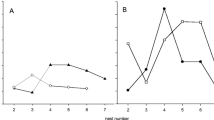Abstract
A crèche is an aggregation of chicks outside nesting territories, within chicks continue to be fed only by their own parents. Several adaptive functions of crèching have been proposed, the most frequent being a reduction in predator pressure. Using an evolutionary stable strategy approach based on the computation of individuals' fecundity, we examined which regime of aerial and terrestrial predation is likely to favour the evolution and stability of the crèching strategy (CS) in gulls. Our results confirm the hypothesis that habitat instability associated with high levels of terrestrial predation favours the evolution and maintenance of crèching behaviour. Moreover, our results suggest that a low aggressiveness against predators may be a pre-adaptation to a CS. In contrast, the high synchronisation often observed in crèching species does not favour the evolution of a crèching behaviour and is thus probably under selection pressures different from those modelled here.
Similar content being viewed by others
References
Beer, C.G. (1966) Adaptation to nesting habitat in the reproductive behaviour of the Black-billed gull (Larus bulleri). Ibis 108, 394–410.
Buckley, F.G. and Buckley, P.A. (1972) The breeding ecology of royal terns Sterna (Thalasseus) maxima maxima. Ibis 114, 344–359.
Carter, H.R. and Hobson, K.A. (1988) Creching behavior of Brandt's cormorant chicks. The Condor 90, 395–400.
Danchin, E. and Wagner, R.H. (1997) The evolution of coloniality: the emergence of new perspectives. Trends Evol. Ecol. 12, 342–347.
del Hoyo, J., Elliot, A. and Argatal, J. (1996) Handbook of the Birds of the World. Lynx Edicions, Barcelona.
Evans, R.M. (1984) Some causal and functional correlates of creching in young White pelicans. Can. J. Zool. 62, 814–819.
Gochfeld, M. (1980) Mechanism and adaptive value of reproductive synchrony in colonial seabirds. In J. Burger, B.L. Olla and H.E. Winn (eds) Behavior of Marine Animals. Plenum Press, New York, London.
Hamilton, W.J. (1971) Geometry for the selfish herd. J. Theor. Biol. 31, 295–311.
Isenmann, P. (1976) Contribution à l'étude de la biologie de la reproduction et de l'étho-écologie du goéland railleur, Larus genei. Ardea 64, 48–61.
Kruuk, H. (1967) Predator and anti-predator behaviour of the Black-headed gull (Larus ridibundus L.). Behaviour (Suppl. 11), 1–129.
Maynard Smith, J. (1982) Evolution and the Theory of Games. Cambridge University Press, London.
Mierauska, P. and Buzun. V. (1991) Competitive Interactions between the Herring gull L. a cachinnans and the Great Black-headed gull L. ichthyaetus at Sivash Lake (South Ukraine). Seevögel 12, 34–35.
Patterson, I.J. (1965) Timing and spacing of broods in the Black-headed gull Larus ridibundus. Ibis 107, 433–459.
Pettingill, J.O.S. (1960) Crèche behavior and individual recognition in colony of Rockhopper penguins. Wilson Bull. 72, 213–221.
Schaller, G.B. (1964) Breeding behavior of the White pelican at Yellowstone Lake, Wyoming. The Condor 66, 3–23.
Sibley, C.G. and Ahlquist, J.E. (1990) Phylogeny and Classification of Birds. Yale University Press, New Haven, Connecticut, USA.
Siegel-Causey, D. and Kharitonov, S.P. (1991) The evolution of coloniality. Curr. Ornithol. 7, 285–330.
Spurr, E.B. (1975) Behavior of the Adélie penguin. The Condor 77, 272–280.
Tinbergen, N. (1956) On the functions of territory in gulls. Ibis 98, 401–411.
Tinbergen, N. (1959) Comparative studies on the behaviour of gulls (Laridae): a progress report. Behaviour 15, 1–70.
Veen, J. (1977) Functional and Causal aspects of nest distribution in colonies of the Sandwich tern. Behaviour (Suppl. XX), 1–193.
Wittenberger, J.F. and Hunt, G.L. (1985) The adaptive significance of coloniality in birds. Avian Biol. 8, 1–78.
Zubakin, V.A. (1985) Types of coloniality in the family Laridae. Proc. Int. Ornithol. congr. 18, 1250–1252.
Zubakin, W.A. and Flint, W.E. (1980) Okologie und Verhalten der Reliktmö we (Larus relictus Lö nnb.). Beitr. Vogelkd. 26, 253–275.
Author information
Authors and Affiliations
Corresponding author
Rights and permissions
About this article
Cite this article
Besnard, A., Gimenez, O. & Lebreton, JD. A model for the evolution of crèching behaviour in gulls. Evolutionary Ecology 16, 489–503 (2002). https://doi.org/10.1023/A:1020809528816
Issue Date:
DOI: https://doi.org/10.1023/A:1020809528816




